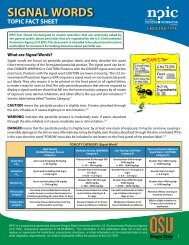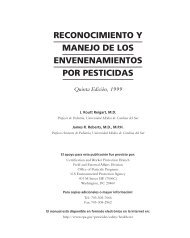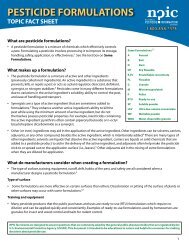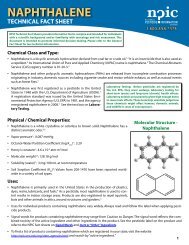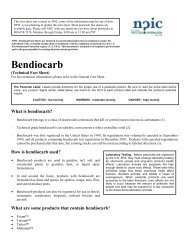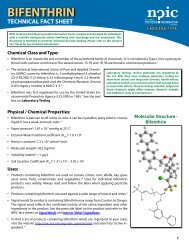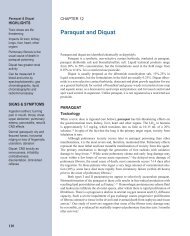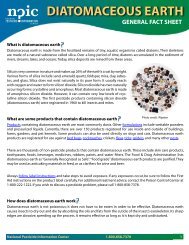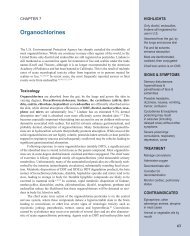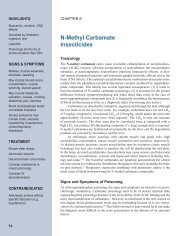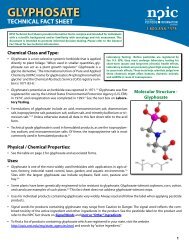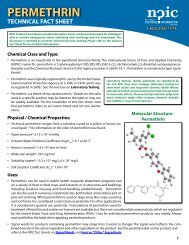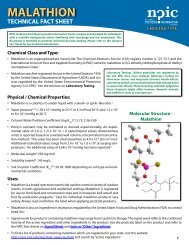CAPSAICIN - National Pesticide Information Center - Oregon State ...
CAPSAICIN - National Pesticide Information Center - Oregon State ...
CAPSAICIN - National Pesticide Information Center - Oregon State ...
Create successful ePaper yourself
Turn your PDF publications into a flip-book with our unique Google optimized e-Paper software.
<strong>CAPSAICIN</strong><br />
TECHNICAL FACT SHEET<br />
Chemical Class and Type:<br />
• Capsaicin is an animal repellent that has also been registered<br />
for use as an insecticide, miticide, rodenticide, and feeding<br />
depressant. 1 The International Union of Pure and Applied<br />
Chemistry (IUPAC) chemical name is 8-methyl-n-vanillyl-<br />
6-nonenamide and the Chemical Abstracts Service (CAS)<br />
registry number is 404-86-4. 2 Capsaicin is a phenylpropanoid<br />
compound. 3<br />
• Capsaicin is obtained from peppers which are the fruit from plants in the genus Capsicum. The peppers are ground<br />
into a fine powder. This may be further refined to the oleoresin, which is a reddish-brown liquid with little odor. 2 When<br />
extracted from plants, the capsicum oleoresin may contain many volatile compounds in addition to capsaicin. 4 Capsicum<br />
annum fruits contained 1.27% capsaicinoids, and 0.03% capsaicin. 5<br />
•<br />
2 Capsaicin was first registered for use in the United <strong>State</strong>s in 1962. It is classified as a biochemical pesticide due to its<br />
mode of action and the fact that it is a naturally occurring substance. 2 See the text box on Laboratory Testing.<br />
Physical / Chemical Properties:<br />
•<br />
6 Vapor pressure : Very low<br />
• Octanol-Water Partition Coefficient (log Kow<br />
)7 : 3.04<br />
•<br />
•<br />
•<br />
7 -13 3 Henry’s constant : 1 x 10 atm·m /mol at 25 °C<br />
7 Molecular weight : 305.462 g/mol<br />
7 Solubility (water) : 10.3 mg/L at 25 °C<br />
• Soil Sorption Coefficient (Koc<br />
)7 : 1.10 x 103 Uses:<br />
• Capsaicin is used on vegetation such as crops and trees, buildings, and garbage containers. It is registered to repel<br />
vertebrate pests such as rabbits, squirrels, deer, voles, raccoons, cats, dogs, and skunks. It is also used as an attack deterrent<br />
for dogs and bears. 1 Uses for individual products containing capsaicin vary widely. Always read and follow the label when<br />
applying pesticide products.<br />
•<br />
•<br />
NPIC Technical Fact Sheets provide information that is complex and intended for individuals<br />
with a scientific background and/or familiarity with toxicology and risk assessment. This<br />
document is intended to promote informed decision-making. Please refer to the General<br />
Fact Sheet for less technical information.<br />
It is applied to foliage of plants to deter feeding by insects such as spider mites, lace bugs, and other invertebrates.<br />
Capsaicin is used as an insecticide in addition to its use as a repellent. 8<br />
Capsaicin is toxic to some bacteria and has been evaluated for use as a marine antifoulant.<br />
Laboratory Testing: Before pesticides are registered by the<br />
U.S. EPA, they must undergo laboratory testing for shortterm<br />
(acute) and long-term (chronic) health effects. Laboratory<br />
animals are purposely given high enough doses to<br />
cause toxic effects. These tests help scientists judge how<br />
these chemicals might affect humans, domestic animals,<br />
and wildlife in cases of overexposure.<br />
Molecular Structure - Capsaicin<br />
• Signal words for products containing capsaicin may range from Caution to Danger. The signal word reflects the<br />
combined toxicity of the active ingredient and other ingredients in the product. See the pesticide label on the product<br />
and refer to the NPIC fact sheets on Signal Words and Inert or “Other” Ingredients.<br />
9<br />
1<br />
1
<strong>CAPSAICIN</strong><br />
TECHNICAL FACT SHEET<br />
•<br />
To find a list of products containing capsaicin which are registered in your state, visit the website<br />
http://npic.orst.edu/reg/state_agencies.html and search by “active ingredient.”<br />
10 • In addition to its use as a pesticide, capsaicin is used in law enforcement and as an ingredient in cosmetics. Medical<br />
researchers have studied capsaicin and its interaction with the TRVP1 receptor for use in pain management. 11,12 Capsaicin<br />
also has been evaluated for treatment of some cancers. 14<br />
Mode of Action:<br />
Target Organisms<br />
15 • Inhalation results in inflammation of pulmonary tissue and damage to respiratory cells. Capsaicin also irritates skin,<br />
sometimes severely. 16,17<br />
•<br />
In insects, capsaicin’s toxicity appears to be through metabolic disruption, membrane damage, and nervous system<br />
dysfunction. 8 Capsaicin has also been shown to repel insects as well as kill them. 18<br />
3 • Capsaicin triggers the release of the neuropeptide P from the sensory nerve fibers of the C type. In mammals, capsaicin<br />
binds to the TRPV1 vanilloid receptor. 15 The TRPV1 receptor then releases sensory neuropeptides that trigger a<br />
neurogenic inflammatory response. 13,19<br />
Non-target Organisms<br />
• Modes of toxicity for non-target organisms are expected to be similar to those of targeted insects and mammals.<br />
Capsaicin is considered toxic to honeybees and other beneficial insects. 8 Although birds have the TRPV1 receptor, it is not<br />
activated by capsaicin. 20,21 No information was available regarding toxicity of capsaicin to fish or other aquatic life. 2<br />
Acute Toxicity:<br />
Oral<br />
• Acute oral LD values were determined to be 97.4 mg/kg and 118.8 mg/kg in female and male mice, respectively, and<br />
50<br />
148.1 mg/kg and 161.2 mg/kg in female and male rats, respectively. 22 See the text boxes on Toxicity Classification and<br />
LD /LC .<br />
50 50<br />
High Toxicity<br />
TOXICITY CLASSIFICATION - <strong>CAPSAICIN</strong><br />
Moderate Toxicity Low Toxicity Very Low Toxicity<br />
Acute Oral<br />
LD<br />
50<br />
Up to and including 50 mg/kg<br />
(≤ 50 mg/kg)<br />
Greater than 50 through 500<br />
mg/kg<br />
(> 50 – 500 mg/kg)<br />
Greater than 500 through<br />
5000 mg/kg<br />
(> 500 – 5000 mg/kg)<br />
Greater than 5000 mg/kg<br />
(> 5000 mg/kg)<br />
Inhalation<br />
LC<br />
50<br />
Up to and including 0.05 mg/L<br />
(≤ 0.05 mg/L)<br />
Greater than 0.05 through<br />
0.5 mg/L<br />
(>0.05 – 0.5 mg/L)<br />
Greater than 0.5 through 2.0<br />
mg/L<br />
(> 0.5 – 2.0 mg/L)<br />
Greater than 2.0 mg/L<br />
(> 2.0 mg/L)<br />
Dermal<br />
LD<br />
50<br />
Up to and including 200 mg/kg<br />
(≤ 200 mg/kg)<br />
Greater than 200 through<br />
2000 mg/kg<br />
(> 200 - 2000 mg/kg)<br />
Greater than 2000 through<br />
5000 mg/kg<br />
(>2000 – 5000 mg/kg)<br />
Greater than 5000 mg/kg<br />
(> 5000 mg/kg)<br />
Primary Eye<br />
Irritation<br />
Corrosive (irreversible destruction of<br />
ocular tissue) or corneal involvement or<br />
irritation persisting for more than 21 days<br />
Corneal involvement or other<br />
eye irritation clearing in 8 –<br />
21 days<br />
Corneal involvement or other<br />
eye irritation clearing in 7<br />
days or less<br />
Minimal effects clearing in<br />
less than 24 hours<br />
Primary Skin<br />
Irritation<br />
Corrosive (tissue destruction into the<br />
dermis and/or scarring)<br />
Severe irritation at 72 hours<br />
(severe erythema or edema)<br />
Moderate irritation at 72<br />
hours (moderate erythema)<br />
Mild or slight irritation at<br />
72 hours (no irritation or<br />
erythema)<br />
The highlighted boxes relfect the values in the “Acute Toxicity” section of this fact sheet. Modeled after the U.S. Environmental Protection<br />
Agency, Office of <strong>Pesticide</strong> Programs, Label Review Manual, Chapter 7: Precautionary Labeling. http://www.epa.gov/oppfead1/labeling/lrm/chap-07.pdf<br />
2
<strong>CAPSAICIN</strong><br />
TECHNICAL FACT SHEET<br />
• Additional LD values for male mice were 60-75 and 190 mg/kg depending on the carrier solution when the capsaicin<br />
50<br />
was administered within the stomach. 23<br />
• Studies using mice have reported LD values ranging from 47.2<br />
50<br />
mg/kg 25 to 2500.0 mg/kg. 24<br />
• The LD in humans has been estimated at 0.5-5.0 g/kg.25<br />
50<br />
Dermal<br />
10,16 • Capsaicin can cause skin irritation. Little absorption occurs<br />
across the skin. 12 Edema following dermal exposure in mouse<br />
ears in several studies peaked within 1 hour of application,<br />
although subsequent applications produced less of a<br />
response. 10<br />
•<br />
Capsaicin can severely irritate the eyes, and was found to cause<br />
corneal lesions in rats and mice. 8,10<br />
• The dermal LD was determined to be >512 mg/kg in mice, however no signs of toxicity were noted at the doses<br />
50<br />
tested. 23<br />
Inhalation<br />
• No inhalation LC was found.<br />
50<br />
•<br />
•<br />
•<br />
•<br />
Capsaicin temporarily causes bronchoconstriction, coughing, nausea, and incoordination in the upper body in humans<br />
following inhalation. 26<br />
Airway resistance increased following inhalation of capsaicin in both mild asthmatics and non-asthmatic people at doses<br />
that are below those eliciting the cough response. 27<br />
People suffering from asthma and other respiratory diseases may be more sensitive to capsaicin than other individuals.<br />
A more recent study suggested that people with sensory hyperreactivity have enhanced sensitivity to capsaicin. This was<br />
associated with increased levels of serum nerve growth factors in nasal lavage fluid. 28<br />
Signs of Toxicity - Animals<br />
• Capsaicin produces its repellent effect when it contacts either eye or respiratory tract mucus membranes. Signs of acute<br />
exposure include coughing, inability to vocalize, and temporary blindness. 29<br />
• Mice and rats dosed orally with 96 to 200 mg/kg capsaicin demonstrated immediate salivation, convulsions, reddening<br />
of the skin, and dypsnea, or labored breathing. Animals either died within 26 minutes of dosing, or showed no further<br />
symptoms 24 hours after dosing. 22<br />
•<br />
Inhalation exposure to capsaicinoids in pepper sprays damaged rat bronchial, tracheal, nasal, and alveolar cells, causing<br />
acute inflammation. 15<br />
Signs of Toxicity - Humans<br />
• Exposure to capsaicin pepper spray results in temporary blindness, lacrimation (tear production), burning sensation, pain<br />
and redness on the skin, nasal irritation, coughing, bronchoconstriction, and dyspnea. 26<br />
•<br />
LD 50 /LC 50 : A common measure of acute toxicity is the lethal<br />
dose (LD 50 ) or lethal concentration (LC 50 ) that causes death<br />
(resulting from a single or limited exposure) in 50 percent<br />
of the treated animals. LD 50 is generally expressed as the<br />
dose in milligrams (mg) of chemical per kilogram (kg) of<br />
body weight. LC 50 is often expressed as mg of chemical<br />
per volume (e.g., liter (L)) of medium (i.e., air or water) the<br />
organism is exposed to. Chemicals are considered highly<br />
toxic when the LD 50 /LC 50 is small and practically non-toxic<br />
when the value is large. However, the LD 50 /LC 50 does not reflect<br />
any effects from long-term exposure (i.e., cancer, birth<br />
defects or reproductive toxicity) that may occur at levels<br />
below those that cause death.<br />
Capsaicin administered in a nasal spray resulted in human volunteers experiencing greatly increased nasal discharge and<br />
lacrimation, and burning sensation. 30<br />
3<br />
26
<strong>CAPSAICIN</strong><br />
TECHNICAL FACT SHEET<br />
•<br />
Mucous membranes throughout the gastrointestinal tract from mouth to anus may be temporarily irritated by ingestion<br />
of capsaicin. In addition to irritation, diarrhea and vomiting may occur. 31<br />
• Always follow label instructions and take steps to avoid exposure. If any exposures occur, be sure to follow the First Aid<br />
instructions on the product label carefully. For additional treatment advice, contact the Poison Control <strong>Center</strong> at 1-800-<br />
222-1222. If you wish to report an incident, please call 1-800-858-7378.<br />
Chronic Toxicity:<br />
Animals<br />
• Chronic feeding studies in rodents consistently demonstrated weight loss when animals were either dosed via gavage or<br />
when the capsaicin was mixed with the food. 10 However, another feeding study showed no such effects using ground red<br />
pepper Capsicum annuum at up to 10% of the total diet in mice. 36<br />
• Different diets affected the toxic effects of capsaicin on the liver and spleen in rabbits, such that effects were greatest in<br />
animals fed the high-fat diets. In contrast, animals fed high protein, high carbohydrate diets showed no effects relative to<br />
controls. Test animals were given 5 g/kg of “red pepper” daily for one year. 32<br />
• Researchers applied pure capsaicin topically to the backs of mice once weekly for 26 weeks. Doses of 0.64, 1.28, and 2.56<br />
mg/mouse/week resulted in skin abnormalities including inflammation, epidermal crusts, epidermis thickening, and<br />
ulcerations. 33 Other signs included gross lesions in the stomach, salivary glands, and oral cavity. 33<br />
• Capsaicin applied to the hind paws of rats twice daily for 10 weeks led to increased pain sensitivity in the animals<br />
exposed to the highest dose (0.75% capsaicin) although this sensitivity decreased with time. 34 Rats treated with a lower<br />
dose (0.075% capsaicin) demonstrated reduced function in certain cells known as C fibers following prolonged dosing,<br />
but this impairment disappeared after treatment stopped. 34<br />
Humans<br />
• No information was found regarding NOEL, LOEL, PAD, or reference dose (RfD) values for capsaicin. See the text box on<br />
Exposure.<br />
• Chronic exposure to capsaicin in a factory setting resulted in cough thresholds that were related to the extent of<br />
exposure on the job. 35 Workers exposed to capsaicin demonstrated a bimodal cough threshold response that was not<br />
observed in unexposed workers, who showed a unimodal response. Some exposed workers were much more sensitive to<br />
capsaicin than other exposed workers. 35<br />
•<br />
A condition known as “Hunan hand”, which is a form of contact dermatitis, has been noted in workers handling<br />
peppers. 16,17<br />
Endocrine Disruption:<br />
•<br />
No data were found regarding possible effects of capsaicin on endocrine systems.<br />
Carcinogenicity:<br />
Animals<br />
• Several researchers reviewed evidence that capsaicin is carcinogenic in animals and found that the evidence was<br />
inconclusive. 10,28,38<br />
Exposure: Effects of capsaicin on human health and the environment depend on how much capsaicin<br />
is present and the length and frequency of exposure. Effects also depend on the health of<br />
a person and/or certain environmental factors.<br />
4
<strong>CAPSAICIN</strong><br />
TECHNICAL FACT SHEET<br />
•<br />
Researchers have demonstrated that capsaicin is mutagenic and genotoxic in some studies using bacterial and rodent<br />
models36 but not in others. 37,38<br />
• Researchers applied pure trans-capsaicin to the dorsal skin of mice weekly for 26 weeks at rates of 0.64, 1.28, or 2.56 mg/<br />
mouse/week. 33 No increase of neoplastic skin lesions or other abnormal skin growth was noted over control mice. 33<br />
•<br />
A lifetime diet containing 0.03% capsaicin fed to mice led to slight increases in benign tumors of the cecum.<br />
40 • Capsaicinoids fed to male mice at 1% of the diet for 79 weeks resulted in kidney lesions in male mice. However, female<br />
mice fed a diet of 0.25% capsaicinoids for 83 weeks developed fewer tumors compared with controls. Hepatocellular<br />
neoplasms, or abnormal growths in the liver, also occurred less often in male and female mice fed greater concentrations<br />
of capsaicinoids in their diet. 40<br />
Humans<br />
• Neither the U.S. EPA nor the International Agency for Research on Cancer (IARC) has published a cancer rating for<br />
capsaicin. See the text box on Cancer.<br />
46 26 • Capsaicin has demonstrated mutagenic effects in some research but not in other studies. Impurities in the extract<br />
may be responsible for mutagenic effects because the studies that failed to demonstrate mutagenic effects used pure<br />
capsaicin. 26,43<br />
•<br />
People consuming 90-250 mg of capsaicin per day (in the form of jalapeno peppers) had a greater risk of gastric cancer<br />
compared with people who consumed less capsaicin (0-29.9 mg capsaicin per day). 41<br />
• Capsaicin exerted an anti-proliferative effect on human prostate cancer cells in vitro in a dose-dependent manner,<br />
completely halting proliferation at 5 x 10-4 mol/L. 14<br />
Reproductive or Teratogenic Effects:<br />
Animals<br />
• Offspring of pregnant rats treated with 8% wet weight capsaicin via a 50<br />
cm2 dermal patch had delayed ossification in their metatarsal bones. This<br />
dose was above the NOEL for the mothers. 42 See the text box on NOAEL,<br />
NOEL, LOAEL, and LOEL.<br />
•<br />
•<br />
Cancer: Government agencies in the United <strong>State</strong>s and abroad have developed programs to evaluate the potential<br />
for a chemical to cause cancer. Testing guidelines and classification systems vary. To learn more about the meaning of<br />
various cancer classification descriptors listed in this fact sheet, please visit the appropriate reference, or call NPIC.<br />
Rabbit fetuses were unaffected at all maternal doses tested although the dams showed signs of toxicity at the higher<br />
doses. 42 The authors concluded that trans-capsaicin should not be considered a developmental toxicant. 42<br />
A review of studies that involved injecting capsaicin into subject animals documented developmental and reproductive<br />
effects such as reduced growth and contraception rates in some studies, but no effects in others. 10<br />
Humans<br />
• No human data were found on the teratogenic or reproductive effects of capsaicin.<br />
NOAEL: No Observable Adverse Effect Level<br />
NOEL: No Observed Effect Level<br />
LOAEL: Lowest Observable Adverse Effect Level<br />
LOEL: Lowest Observed Effect Level<br />
39<br />
5
<strong>CAPSAICIN</strong><br />
TECHNICAL FACT SHEET<br />
Fate in the Body:<br />
Absorption<br />
• Little absorption occurs across the skin.<br />
•<br />
12<br />
Researchers applied 0.8 g of gel containing 0.075% of capsaicin to the skin of six human volunteers for eight hours of<br />
exposure. They then calculated the average absorbed dose as 22.65 µg/cm2 with a standard deviation of 3.73 µg/cm2 . 49<br />
• Topical application of pure capsaicin to the skin of mice resulted in peak plasma concentrations occurring 4 to 12 hours<br />
later, and capsaicin was detectable in the blood 24 hours after dosing. Doses of 5.12 mg/mouse/week led to maximum<br />
plasma concentrations of 51.50 ng/mL in male and 84.80 ng/mL in female mice. 33<br />
•<br />
Capsaicin fed to rats was rapidly absorbed from the stomach, with 85% of a 3 mg dose absorbed within three hours.<br />
Distribution<br />
• Rats injected intravenously accumulated capsaicin primarily in the brain and spinal cord three minutes after dosing, with<br />
lower levels found in the liver and blood. Ten minutes after dosing, the greatest concentrations remained in the spinal<br />
cord. 44<br />
• When the capsaicin was injected subcutaneously, rat blood concentrations peaked five hours following dosing, and brain<br />
and spinal cord tissue concentrations were somewhat lower. Kidneys contained the greatest concentrations and liver<br />
concentrations were low. Researchers detected capsaicin in all tissues 10 minutes following dosing but residues were<br />
undetectable in any tissues 17 hours later. 44 The researchers concluded that the low concentrations in the liver were due<br />
to metabolic breakdown of the capsaicin.<br />
•<br />
Distribution data for capsaicin in humans were not found.<br />
Metabolism<br />
• Metabolism occurs primarily by the liver in the rat.<br />
•<br />
45<br />
Metabolism of capsaicin by P450 enzymes may follow a number of pathways and produce a variety of metabolites, some<br />
of which may be associated with increased toxicity. 46<br />
• Research using human, rat, mouse, goat, and rabbit liver and lung microsomes demonstrated that metabolism rates were<br />
much greater in liver microsomes compared with lung microsomes for each species. Although the same metabolites<br />
were produced, the relative amounts of each metabolite were species-dependent. 47<br />
•<br />
No metabolism data were found for humans.<br />
Excretion<br />
• Less than 10% of an oral dose of capsaicin given to rats was excreted unchanged 48 hours after dosing.<br />
•<br />
•<br />
No information on urinary/fecal metabolites and biomarkers was available.<br />
No data for human excretion were found.<br />
Medical Tests and Monitoring:<br />
•<br />
Medical tests are not generally available to detect or quantify capsaicin in the human body.<br />
Environmental Fate:<br />
Soil<br />
• Capsaicin should not be very mobile in soil based on its chemical properties.<br />
•<br />
Volatilization from either wet or dry soil is not expected based on the Henry’s Law Constant and the vapor pressure,<br />
respectively. 7<br />
7<br />
43<br />
43<br />
6
<strong>CAPSAICIN</strong><br />
TECHNICAL FACT SHEET<br />
• Soil bacteria break capsaicin down into vanillylamine, which is<br />
further broken down into vanillin, vanillyl alcohol and vanillic<br />
acid. 48<br />
• Capsaicin applied to a compacted sandy loam with 2.5% organic<br />
matter and a pH of 7.9 did not move from the point of application<br />
over a 9-day period, with unspecified irrigation or rainfall. 49<br />
Researchers concluded that soil compaction may have prevented<br />
movement. 49<br />
• Researchers studying persistence of capsicum oleoresin in a<br />
sandy loam soil estimated half-lives of 2 to 8 days. 50 Researchers<br />
suspected that the capsicum oleoresin leached from the test soil<br />
based on the color of the water collected at the base of the test<br />
bins. 50 See the text box on Half-life.<br />
Water<br />
• Breakdown by photolysis or hydrolysis is not expected due to capsaicin’s molecular structure and solubility.<br />
• Based on its Kow<br />
and K values, capsaicin is predicted to bind to the surface of sediments and suspended solids.7<br />
oc<br />
Therefore, the potential for groundwater contamination by capsaicin is low.<br />
•<br />
•<br />
Capsaicin has a low potential for volatilization based on its vapor pressure.<br />
Laboratory and field data related to capsaicin’s fate in water were not available.<br />
Air<br />
• Due to its low vapor pressure, capsaicin will exist only in particulate form in the atmosphere, and be subject to wet and<br />
dry deposition processes. 7<br />
•<br />
Capsaicin’s chemical structure suggests that photolysis will not be a major degradation pathway.<br />
Plants<br />
• Capsaicin is an extract of the fruits of the plants in the genus Capsicum. 2<br />
•<br />
No information was found regarding the transport, distribution, or metabolism of capsaicin in plants, nor were data<br />
available for the foliar half-life of capsaicin.<br />
Indoor<br />
• No data were found on capsaicin’s indoor persistence.<br />
Food Residue<br />
• Capsaicin has been used in human cuisine as an ingredient and as a condiment for many years.<br />
•<br />
Capsaicin is exempted from the requirement of a residue tolerance.<br />
Ecotoxicity Studies:<br />
Birds<br />
• No toxicity information or field studies involving birds were found for capsaicin.<br />
•<br />
Birds do not detect capsaicin. Although birds possess the TRVP1 receptor in their nerve cells, it is not activated by<br />
capsaicin as it is in mammals. 20,21<br />
51<br />
The “half-life” is the time required for half of the compound<br />
to break down in the environment.<br />
7<br />
1 half-life = 50% remaining<br />
2 half-lives = 25% remaining<br />
3 half-lives = 12% remaining<br />
4 half-lives = 6% remaining<br />
5 half-lives = 3% remaining<br />
Half-lives can vary widely based on environmental<br />
factors. The amount of chemical remaining after a<br />
half-life will always depend on the amount of the<br />
chemical originally applied. It should be noted that<br />
some chemicals may degrade into compounds of toxicological<br />
significance.<br />
7<br />
16,17,41<br />
7<br />
7
<strong>CAPSAICIN</strong><br />
TECHNICAL FACT SHEET<br />
•<br />
52 Ecologically, capsaicinoids may function to protect the seeds within the fruit. They may also influence seed dispersal<br />
patterns by influencing gut retention times of the seeds, resulting in more successful plant reproduction. 53<br />
Fish and Aquatic Life<br />
• No studies were found evaluating the toxicity of capsaicin to aquatic life.<br />
•<br />
•<br />
In its Reregistration Eligibility Decision, the U.S. EPA waived the ecological effects studies that are typically required<br />
because it was determined that restrictive labeling would adequately protect aquatic species. 2<br />
Based on its chemical characteristics, a moderate potential for bioconcentration is expected for capsaicin.<br />
Terrestrial Invertebrates<br />
• Capsaicin is toxic to bees and other beneficial insects.<br />
•<br />
No other information for terrestrial invertebrates<br />
was found.<br />
Regulatory Guidelines:<br />
•<br />
•<br />
No reference dose (RfD) exists for capsaicin. See the<br />
text box on Reference Dose (RfD) text box.<br />
No cancer classification has been made for<br />
capsaicin. See the text box on Cancer (page 5).<br />
Date Reviewed: October 2008<br />
8<br />
Reference Dose (RfD): The RfD is an estimate of the quantity of chemical<br />
that a person could be exposed to every day for the rest of their life<br />
with no appreciable risk of adverse health effects. The reference dose is<br />
typically measured in milligrams (mg) of chemical per kilogram (kg) of<br />
body weight per day.<br />
U.S. Environmental Protection Agency, Technology Transfer Network, Air Toxics Health<br />
Effects Glossary, 2009. http://www.epa.gov/ttnatw01/hlthef/hapglossaryrev.html#RfD<br />
Please cite as: Gervais, J. A. ; Luukinen, B.; Buhl, K.; Stone, D. 2008. Capsaicin Technical Fact Sheet; <strong>National</strong> <strong>Pesticide</strong><br />
<strong>Information</strong> <strong>Center</strong>, <strong>Oregon</strong> <strong>State</strong> University Extension Services. http://npic.orst.edu/factsheets/Capsaicintech.pdf.<br />
References<br />
1. <strong>Pesticide</strong> Products. Pest-Bank [CD-ROM] 2007.<br />
2. Reregistration Eligibility Decision (RED) Capsaicin, Case 4018;<br />
U.S. Environmental Protection Agency, Office of Prevention,<br />
<strong>Pesticide</strong>s and Toxic Substances, Office of <strong>Pesticide</strong> Programs, U.S. Government Printing Office: Washington, DC, 1992.<br />
3. Flomenbaum, N. E.; Goldfrank, L. R.; Hoffman, R. S.; Howland, M. A.; Lewin, N. A.; Nelson, L. S. Goldfrank’s Toxicologic<br />
Emergencies, 8th ed.; McGraw Hill: New York, 2006.<br />
4. Lee, R. J.; Yolton, R. L.; Janin, M. L. Personal Defense Sprays: Effects and Management of Ocular and Systemic Exposure. http://<br />
www.opt.pacificu.edu/ce/catalog/13541-SD/pepper.html (accessed Dec 2003), updated 2006.<br />
5. Azizan, A.; Blevins, R. D. Mutagenicity and antimutagenicity testing of six chemicals associated with the pungent<br />
properties of specific spices as revealed by the Ames Salmonella/microsomal assay. Arch. Environ. Contam. Toxicol. 1995,<br />
28, 248-258.<br />
6. Tucker, S. P. Capsaicin and Dihydrocapsaicin: Method 5041. NIOSH Manual of Analytical Methods, 4th ed.; Schlecht, P. C.;<br />
O’Connor, P. F., Eds.; U.S. Department of Health and Human Services, <strong>Center</strong>s for Disease Control, <strong>National</strong> Institute for<br />
Occupational Safety and Health: Atlanta,1996.<br />
7. Hazardous Substances Data Bank (HSDB), Capsaicin;<br />
U.S. Department of Health and Human Services, <strong>National</strong> Institutes<br />
of Health, <strong>National</strong> Library of Medicine: Bethesda, MD, 2006.<br />
8. Copping, L. G. The Bio<strong>Pesticide</strong> Manual, 2nd ed.; British Crop Protection Council: Farnham, UK, 2001; pp 171-172.<br />
9. Xu, Q.; Barrios, C. A.; Cutright, T.; Newby, B. Z. Evaluation of toxicity of capsaicin and zosteric acid and their potential<br />
application as antifoulants. Environ. Toxicol. 2005, 20 (5), 467-474.<br />
8<br />
7
<strong>CAPSAICIN</strong><br />
TECHNICAL FACT SHEET<br />
10. Johnson Jr., W. Final report on the safety assessment of Capsicum annuum extract, Capsicum annuum fruit extract,<br />
Capsicum annuum resin, Capsicum annuum fruit powder, Capsicum frutescens fruit, Capsicum frutescens fruit extract,<br />
Capsicum frutescens resin, and capsaicin. Int. J. Toxicol. 2007, 26 (Suppl. 1), 3-106.<br />
11. Mason, L.; Moore, R. A.; Derry, S.; Edwards, J. E.; McQuay, H. J. Systematic review of topical capsaicin for the treatment of<br />
chronic pain. Br. Med. J. 2004, 328 (7446), 991-994.<br />
12. Knotkova, H.; Pappagallo, M.; Szallasi, A. Capsaicin (TRPV1 agonist) therapy for pain relief: farewell or revival? Clin. J. Pain<br />
2008, 24 (2), 143-154.<br />
13. Pall, M. L.; Anderson, J. H. The vanilloid receptor as a putative target of diverse chemicals in multiple chemical sensitivity.<br />
Arch. Environ. Health 2004, 59 (7), 363-375.<br />
14. Mori, A.; Lehmann, S.; O’Kelly, J.; Kumagai, T.; Desmond, J. C.; Pervan, M.; McBride, W. H.; Kizaki, M.; Koeffler, H. P. Capsaicin,<br />
a component of red peppers, inhibits the growth of androgen-independent, p53 mutant prostate cancer cells. Cancer<br />
Res. 2006, 66 (6), 3222-3229.<br />
15. Reilly, C. A.; Taylor, J. L.; Lanza, D. L.; Carr, B. A.; Crouch, D. J.; Yost, G. S. Capsaicinoids Cause Inflammation and Epithelial Cell<br />
Death through Activation of Vanilloid Receptors. Toxicol. Sci. 2003, 73, 170-181.<br />
16. Burnett, J. W. Capsicum Pepper Dermatitis. Cutis 1989, 43, 534.<br />
17. Williams, S. R.; Clark, R. F.; Dunford, J. V. Contact Dermatitis Associated with Capsaicin: Hunan Hand Syndrome. Ann. Emerg.<br />
Med. 1995, 25, 713-715.<br />
18. Antonious, G. F.; Meyer, J.; Snyder, J. C. Toxicity and repellency of hot pepper extracts to spider mite, Tetranychus urticae<br />
Koch. J. Environ. Sci. Health B 2006, 41, 1383-1391.<br />
19. Gharat, L.; Szallasi, A. Medicinal chemistry of the vanilloid (Capsaicin) TRPV1 receptor: current knowledge and future<br />
perspectives. Drug Develop. Res. 2007, 68, 477-497.<br />
20. Geisthövel, E.; Ludwig, O.; Simon, E. Capsaicin fails to produce disturbances of autonomic heat and cold defence in an<br />
avian species (Anas platyrhynchos). Pflügers Arch. 1986, 406, 343-350.<br />
21. Jordt, S.-E.; Julius, D. Molecular basis for species-specific sensitivity to “hot” chili peppers. Cell 2002, 108, 421-430.<br />
22. Saito, A.; Yamamoto, M. Acute Oral Toxicity of Capsaicin in Mice and Rats. J. Toxicol. Sci. 1996, 21, 195-200.<br />
23. Glinsukon, T.; Stitmunnaithum, V.; Toskulkao, C.; Buranawuti, T.; Tangkrisanavinot, V. Acute toxicity of capsaicin in several<br />
animal species. Toxicon 1980, 18, 215-220.<br />
24. Meister, R. T.; Sine, C., Capsaicin. Meister Media Worldwide: Willoughby, OH, 2007; Vol. 93.<br />
25. Lewis Sr., R. J. Sax’s Dangerous Properties of Industrial Materials, 10th ed.; John Wiley & Sons, Inc.: New York, 2000; p 702.<br />
26. Chanda, S.; Erexon, G.; Raich, C.; Innes, D.; Stevenson, F.; Murli, H.; Bley, K. Genotoxicity studies with pure trans-capsaicin.<br />
Mutat. Res. 2004, 557, 85-97.<br />
27. Gosselin, R. E.; Hodge, H. C.; Smith, R. P.; Gleason, M. N. Clinical Toxicology of Commercial Products, 4th ed.; The Williams and<br />
Wilkins Company: Baltimore, 1976; p 145.<br />
28. Busker, R. W.; van Helden, H. P. M. Toxicologic Evaluation of Pepper Spray as a Possible Weapon for the Dutch Police Force.<br />
Am. J. Forensic Med. Pathol. 1998, 19 (4), 309-316.<br />
29. Fuller, R. W. Pharmacology of inhaled capsaicin in humans. Respir. Med. 1991, 85 (Suppl. A), 31-34.<br />
30. Collier, J. G.; Fuller, R. W. Capsaicin inhalation in man and the effects of sodium cromoglycate. Br. J. Pharmac. 1984, 81,<br />
113-117.<br />
31. Millqvist, E.; Ternesten-Hasseus, E.; Stahl, A.; Bende, M. Changes in levels of nerve growth factor in nasal secretions after<br />
capsaicin inhalation in patients with airway symptoms from scents and chemicals. Environ. Health Perspect. 2005, 13 (7),<br />
849-852.<br />
32. Miller, D. S. Review of oleoresin capsicum (pepper) sprays for self-defense against captive wildlife. Zoo Biol. 2001, 20,<br />
389-398.<br />
9
<strong>CAPSAICIN</strong><br />
TECHNICAL FACT SHEET<br />
33. Philip, G.; Baroody, F. M.; Proud, D.; Naclerio, R. M.; Togias, A. G. The human nasal response to capsaicin. J. Allergy Clin.<br />
Immunol. 1994, 94, 1035-1045.<br />
34. Tominack, R. L.; Spyker, D. A. Capsicum and Capsaicin - A Review: Case Report of the Use of Hot Peppers in Child Abuse.<br />
Clin. Toxicol. 1987, 25 (7), 591-601.<br />
35. Jang, J. J.; Devor, D. E.; Logsdon, D. L.; Ward, J. M. A 4-Week Feeding Study of Ground Red Chili ( Capsicum annuum) in Male<br />
B6C3F Mice. Food Chem. Toxicol. 1992, 30 (9), 783-787.<br />
1<br />
36. Lee, S. O. Studies on the influence of diets and lipotropic substances upon the various organs and metabolic changes in<br />
rabbits on long term feeding with red pepper. Korean J. Intern. Med. 1963, 6 (7), 383-395.<br />
37. Chanda, S.; Erexon, G.; Frost, D.; Babbar, S.; Burlew, J.-A.; Bley, K. 26-week dermal oncogenicity study evaluating pure<br />
trans-capsaicin in Tg.AC hemizygous mice (FBV/N). Intern. J. Toxicol. 2007, 26, 123-133.<br />
38. McMahon, S. B.; Lewin, G.; Bloom, S. R. The consequences of long-term topical capsaicin application in the rat. Pain 1991,<br />
44, 301-310.<br />
39. R.E.D. Facts Capsaicin;<br />
U.S. Environmental Protection Agency, Office of Prevention, <strong>Pesticide</strong>s and Toxic Substances,<br />
Office of <strong>Pesticide</strong> Programs, U.S. Government Printing Office: Washington, DC, 1992.<br />
40. Blanc, P.; Liu, D.; Juarez, C.; Boushey, H. A. Cough in Hot Pepper Workers. Chest 1991, 99, 27-32.<br />
41. Marques, S.; Oliveira, N. G.; Chaveca, T.; Rueff, J. Micronuclei and sister chromatid exchanges induced by capsaicin in<br />
human lymphocytes. Mutat. Res. 2002, 517, 39-46.<br />
42. Proudlock, R.; Thompson, C.; Longstaff, E. Examination of the potential genotoxicity of pure capsaicin in bacterial<br />
mutation, chromosome aberration, and rodent micronucleus tests. Environ. Mol. Mutagen. 2004, 44, 441-447.<br />
43. Toth, B.; Gannett, P. Carcinogenicity of lifelong administration of capsaicin of hot pepper in mice. In Vivo 1992, 6, 59-63.<br />
44. Akagi, A.; Sano, N.; Uehara, H.; Minami, T.; Otsuka, H.; Izumi, K. Non-carcinogencity of capsaicinoids in B6C3F mice. Food<br />
1<br />
Chem. Toxicol. 1998, 36, 1065-1071.<br />
45. Richeux, R.; Cascante, M.; Ennamany, R.; Sabureau, D.; Creppy, E. E. Cytotoxicity and genotoxicity of capsaicin in human<br />
neuroblastoma cells SHSY-5Y. Arch. Toxicol. 1999, 73, 403-409.<br />
46. Lopez-Carrillo, L.; Lopez-Cervantes, M.; Robles-Diaz, G.; Ramirez-Espitia, A.; Mohar-Betancourt, A.; Meneses-Garcia, A.;<br />
Lopez-Vidal, Y.; Blair, A. Capsaicin consumption, Heliobacter pylori postitivity and gastric cancer in Mexico. Intern. J.<br />
Cancer 2003, 106, 277-282.<br />
47. Chanda, S.; Sharper, V. A.; Hoberman, A. M.; Bley, K. Developmental toxicity study of pure trans-capsaicin in rats and<br />
rabbits. Intern. J. Toxicol. 2006, 25, 205-217.<br />
48. Fang, J.; Tsai, M.; Huang, Y.; Wu, P.; Tsai, Y. Percutaneous absorption and skin erythema: quantification of capsaicin and<br />
its synthetic derivatives from gels incorporated with benzalkonium chloride by using non-invasive bioengineering<br />
methods. Drug Develop. Res. 1997, 40, 56-67.<br />
49. Kawada, T.; Suzuki, T.; Takahashi, M.; Iwai, K. Gastrointestinal Absorption and metabolism of Capsaicin and<br />
Dihydrocapsaicin in Rats. Toxicol. Appl. Pharmacol. 1984, 72, 449-456.<br />
50. Saria, A.; Skofitsch, G.; Lembeck, F. Distribution of capsaicin in rat tissues after systemic administration. J. Pharm.<br />
Pharmacol. 1982, 34, 273-275.<br />
10<br />
NPIC is a cooperative agreement between <strong>Oregon</strong> <strong>State</strong> University and the U.S. Environmental Protection<br />
Agency (U.S. EPA, cooperative agreement # X8-83458501). The information in this publication does not in any<br />
way replace or supersede the restrictions, precautions, directions, or other information on the pesticide label or<br />
any other regulatory requirements, nor does it necessarily reflect the position of the U.S. EPA.
<strong>CAPSAICIN</strong><br />
TECHNICAL FACT SHEET<br />
51. Donnerer, J.; Amann, R.; Schuligoi, R.; Lembeck, F. Absorption and Metabolism of capsaicinoids following intragastric<br />
administration in rats. Naunyn Schmiedeberg’s Arch. Pharmacol. 1990, 342, 357-361.<br />
52. Reilly, C. A.; Yost, G. S. Metabolism of capsaicinoids by P450 enzymes: a review of recent findings on reaction<br />
mechanisms, bio-activation, and detoxification processes. Drug Metab. Rev. 2006, 38, 685-706.<br />
53. Reilly, C. A.; Ehlhardt, W. J.; Jackson, D. A.; Kulanthaivel, P.; Mutlib, A. E.; Espina, R. J.; Moody, D. E.; Crouch, D. J.; Yost, G. S.<br />
Metabolism of capsaicin by cytochrome P450 produces novel dehydrogenated metabolites and decreases cytotoxicity<br />
to lung and liver cells. Chem. Res. Toxicol. 2003, 16, 336-349.<br />
54. Onozaki, H.; Asai, H.; Isshiki, S.; Esaki, H. Bacterial metabolism of vanillylamine and vanilline. Hakkokagu Kaishi 1986, 64,<br />
425-430.<br />
55. Sterner, R. T.; Kimball, B. A. Slow migration of capsicum oleoresin in a sandy loam soil. Int. Biodeterior. Biodegradation<br />
2005, 56, 188-191.<br />
56. Sterner, R. T.; Ames, A. D.; Kimball, B. A. Persistence of capsicum oleoresin in soil. Int. Biodeterior. Biodegradation 2002, 49,<br />
145-149.<br />
57. Meat Meal and Red Pepper; Exemption from the Requirement of a Tolerance. Fed. Regist. March 27, 1996, 61 (60), 13424-<br />
13426.<br />
58. Tewksbury, J. J.; Reagan, K. M.; Machnicki, N. J.; Carlo, T. A.; Haak, D. C.; Calderon Penaloza, A. L.; Levey, D. J. Evolutionary<br />
ecology of pungency in wild chilies. Proc. Natl. Acad. Sci. U.S.A. 2008, 105 (33), 11808-11811.<br />
59. Tewksbury, J. J.; Levey, D. J.; Huizinga, M.; Haak, D. C.; Traveset, A. Costs and benefits of capsaicin-mediated control of gut<br />
retention in dispersers of wild chilies. Ecology 2008, 89 (1), 107-117.<br />
For more information contact: NPIC<br />
<strong>Oregon</strong> <strong>State</strong> University, 310 Weniger Hall, Corvallis, OR 97331-6502<br />
Phone: 1-800-858-7378 Fax: 1-541-737-0761<br />
Email: npic@ace.orst.edu Web: npic.orst.edu<br />
11




